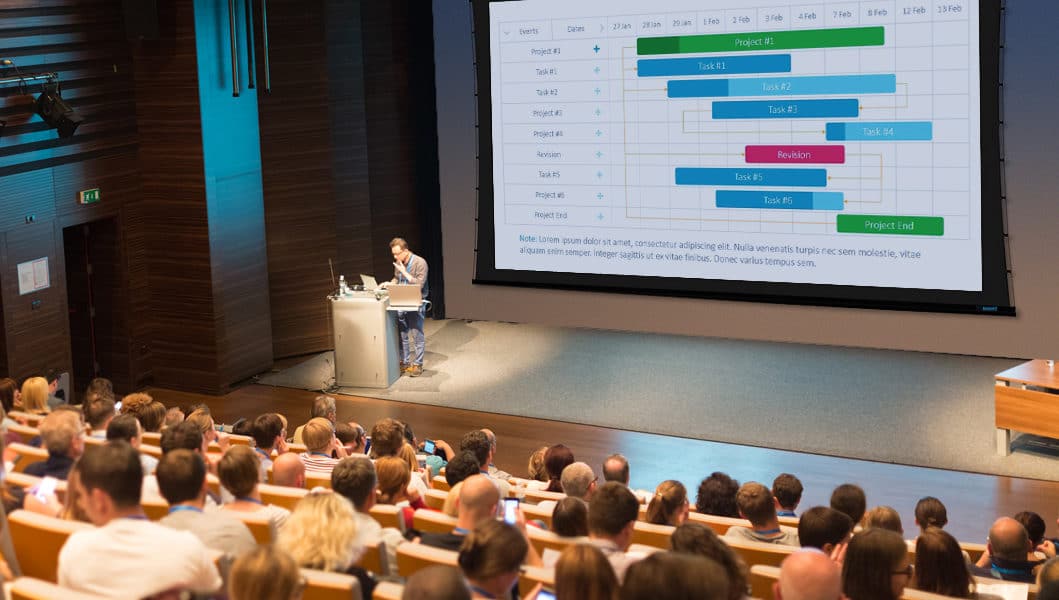By Mark Robinson
There are many factors that play into choosing the correct two-piece projection system. To begin, make sure to maximize your projection system by specifying the best screen for your specific application. The characteristics of the room, the content to be displayed and the quality of the equipment all contribute to the performance of the system.
Light is the enemy of two-piece projection, and it is important to know how well light can be controlled in the room where the screen will be installed. The amount of ambient light greatly affects the quality of the images on screen.
If the room has a lot of natural or artificial light, a screen with ambient light rejecting (ALR) qualities will help in eliminating image washout. Ambient light rejecting screens work by rejecting or absorbing stray light coming from sources other than the projector. The more light in the room, the darker the screen required.
The most important thing to remember is that projectors do not project black light and any black in the image is provided, courtesy of the screen. If room lighting can be completely controlled, then a matte white screen can be used.
Next, determine if the room is a dedicated space, used only to watch on-screen content, or if the room will be used for other purposes. If installing into a dedicated space, a fixed frame screen can be mounted to the wall permanently.
However, if the screen is installed in a room where various other activities take place, a retractable screen is most likely the best choice. Retractable screens can mount either directly onto a wall or they can be recessed into the ceiling. The distinct advantage of a roller screen is that the screen can be completely out of sight when not in use.
It is also important to know where the projector will be mounted. The distance the projector is from the screen, or throw distance, must be taken into account. Projectors are typically mounted 1.5 to 2 times the image width away from the screen.
For example, if the screen is 10 feet wide, the projector should be mounted 15 to 20 feet from the surface of the screen. The configurations of some rooms do not allow for these standard lens specifications and a shorter or longer throw may be the only option.
Gain is the measurement of light coming off a screen as compared to an engineered standard surface, which is a very matte, highly diffusive, pure white surface. In a room with higher ambient light, more projector light is usually needed to make the image bright enough to see.
Larger image areas require more projector light and elevated gain screens can assist in the performance of an underpowered projector. A gain factor of 1.0 exactly matches a reflectance standard when measured on-axis. A gain of .8 reflects 80% of the light that would be seen as measured against the same standard. A surface with a measured gain factor of 1.3, reflects 130% of the light that the standard would deliver. The added reflectivity is not achieved for free. The additional light perceived on-axis with an elevated gain screen is actually redirected light that would have otherwise been distributed off-axis.
If the screen is used in a high ambient light setting, a higher gain is often recommended. Alternatively, a higher output projector can be paired with an ALR screen to improve image contrast. If the screen is used in a low ambient light setting, a lower gain matte white screen can be considered, usually with improved center to edge uniformity and improved color rendition. Lower gain screens also allow wider seating areas to be considered.
Today’s content comes in all different aspect ratios. When choosing a two-piece projection system, it is important to think about the content that will be displayed on the screen and to select a screen built to the most frequently used aspect ratio. The aspect ratio of a screen is the relationship of the width of the screen to the height of the screen. The most commonly used aspect ratio today is 16:9 or HDTV standard. If the content to be displayed fits a standard computer screen, then a 16:10 aspect ratio may be the most appropriate.
Another grouping of aspect ratios is centered on CinemaScope content. Scope content can vary, and most high-end screens employ continuous masking to achieve multiple aspect ratios on the same screen. Masking screens work by blocking off unused parts of the screen using motorized masking panels. When properly implemented, a masking system will adjust the screen aspect ratio based on the content being projected.
The pixel resolution of today’s projectors is constantly being increased. HDTV gave way to 4K and now there are 8K formats emerging and someday, even 16K. The resolution of an image is measured in pixels or small dots of color that make up an image. A 4K image is 4096 pixels wide by 2160 pixels high and is referred to as 4K because the image is approximately 4000 pixels wide.
This same basic naming structure holds true for 8K and 16K images. The more pixels that make up an image, the smaller the pixels become, resulting in higher image fidelity. A high-quality screen surface is comprised of surface particles that are smaller than even the smallest pixel from a projector. This means that a high-quality screen is ready for the highest resolution projector available today and is also ready for future technology.
The quality of the projector and the quality of the projection screen makes a huge difference in performance. If a great projector is matched to an inferior screen, the optimal performance of the projector will not be realized. Conversely, an average projector can be greatly improved by using a high-quality screen.
It is also important to know that if a high-quality screen is installed it will likely last much longer than the projector. In fact, many high-quality screens outlast multiple projectors. Because of this long-lasting investment, it is often said, “Date the projector but marry the screen.”
Mark Robinson is vice president customer experience for Stewart Filmscreen, a premier manufacturer of professional projection screens since 1947, www.stewartfilmscreen.com.





